Dresses always emphasize femininity and attractiveness of the image. There is a huge variety of models of this element of women's wardrobe. Straight or trapezoidal silhouettes are considered especially popular. And a significant detail is considered to be a frill, which frames the shoulder area or neckline. "Burda" offers several interpretations of this version of dresses, which are suitable for summer walks, dinner parties and beach fun.
- Choice of fabric
- Taking measurements
- Methods of making shuttlecocks
- Circular method
- Spiral method
- "Wrong" shuttlecocks
- Modeled according to the pattern
- Construction of the pattern
- Simple model
- Model with straps
- High waist dress
- Dress with several elastic bands
- Fitted silhouette model
- Number of cutting parts
- Sewing
Choice of fabric
The choice of fabric is made depending on the type and functionality of the model. But with some details it is easy to decide - the color or print that will suit and hide all the flaws of the figure. If you take these features into account, then it will be much easier to buy the necessary textiles:
- For children, it is worth choosing light natural fabrics such as cotton or linen.
- Evening options should be made from noble fabrics - velvet, staple, "oil".
- Summer models for women, girls and teenagers can be made from linen, silk, chiffon.
Please note! It is worth choosing high-quality textiles, otherwise the finished product will look sloppy and will quickly become unwearable.

Additionally, you will need accessories in the form of an elastic band, a hidden zipper or a button. You need to prepare tools to do the job. You should take scissors, a measuring tape, chalk, paper, safety pins. Additionally, you will need a sewing machine.
Taking measurements
Any clothing has a certain size. Even the simplest model of a dress with a frill in the shoulder area is set by certain parameters at the stage of preparing the pattern. To accurately guess the size, it is worth taking the necessary measurements. You can use the following diagram:

To be sure you don't make a mistake with the required amount of fabric, you should consider not only the measurements taken, but also the silhouette of the product, seam allowances, and possible shrinkage of the material.
Methods of making shuttlecocks
There are several options for making flounces. Each method differs in the principle of making a pattern, arrangement on a ready-made dress base, appearance and functionality. How to make a flounce:
- in a circle;
- spiral;
- asymmetrical flounces;
- "built-in" into the pattern.
To make this important detail beautiful, you need to study detailed master classes. Then the result will be successful.
Circular method
The circular method is not difficult to make. Even a child can handle this work. The algorithm for forming a frill:
- The blank is considered a frill with a simple configuration. It is a ring of fabric of the corresponding radii.
- It is necessary to honor the parameters of internal and external values.
- The ring must be cut at any place and opened.
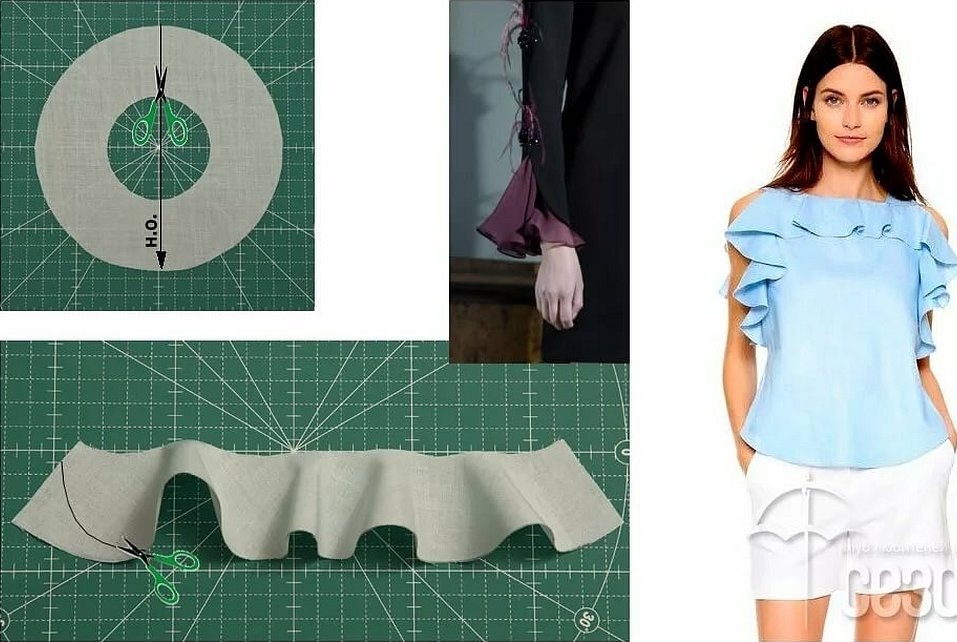
Thanks to this cut, the detail will have natural "waves". The same principle can be implemented by sewing a frill from rectangles of certain parameters. Assembly is done by pulling together the threads of two parallel wide-step lines.
Spiral method
The spiral cut allows you to get "layered" ruffles. The principle of creation:
- The inner radius should be equal to the length of the part divided by a factor of 3.14 and multiplied by 2.
- The outer radius is identical to the inner dimension with the addition of the shuttlecock width value.
- A high-quality spiral is created based on a cross with perpendicular axes. Control points should be marked on it.
- After cutting, the spiral element is unwound.
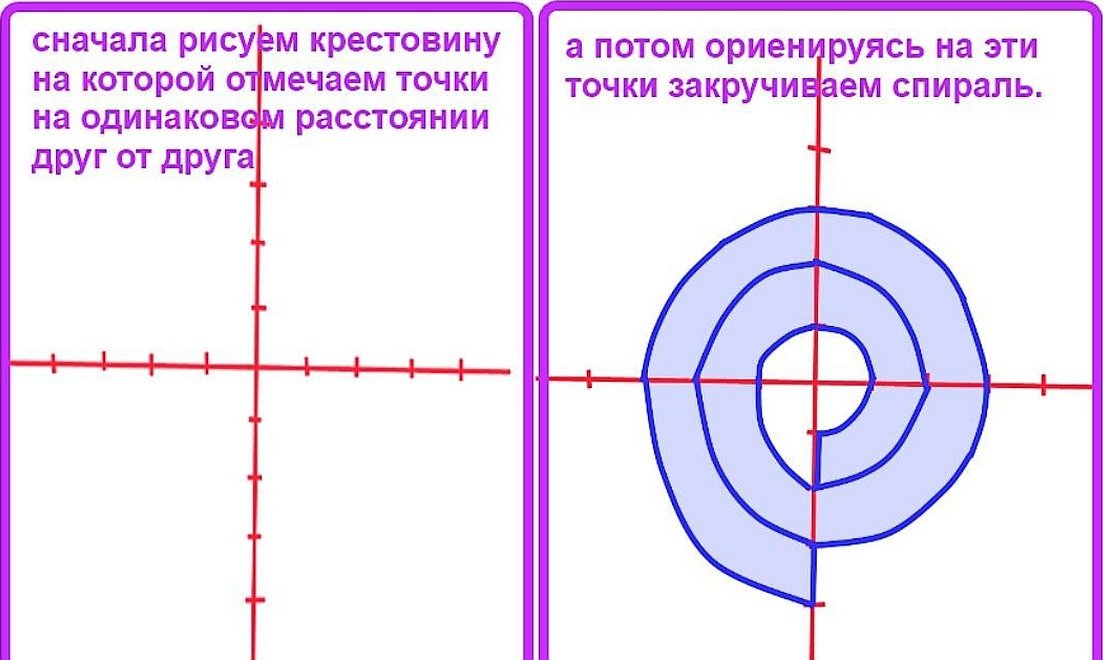
In this case, it is important to make correct calculations in terms of determining the radii and sizes of future frills.
"Wrong" shuttlecocks
To create an open dress style, you can make "irregular" flounces. An irregularly shaped ruffle that tapers toward one end is made using the "circular" method.
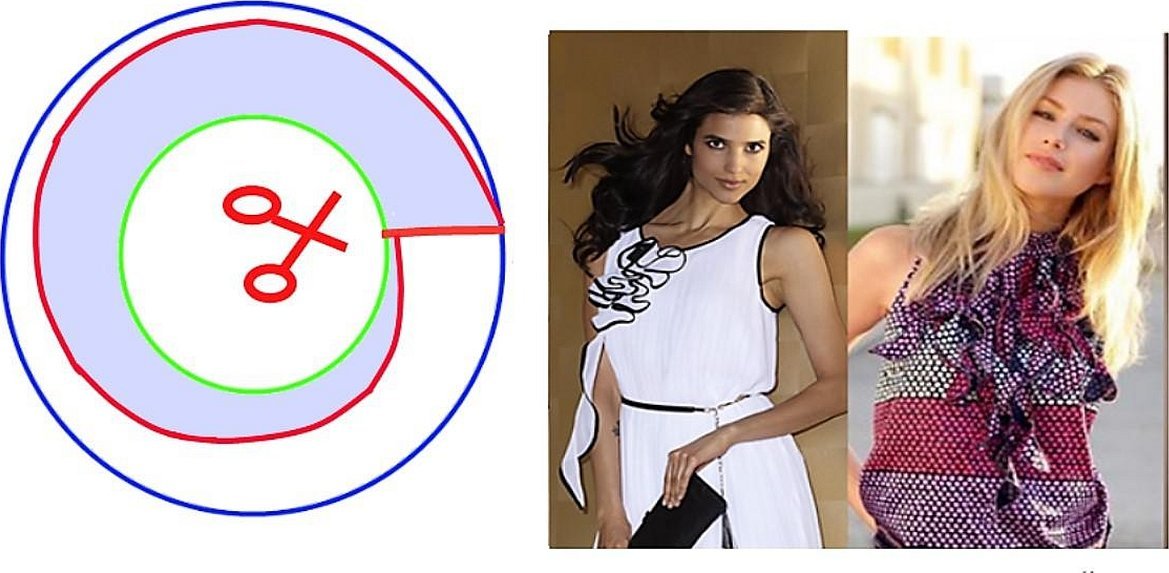
The basic configuration of the outer part of the circle pattern is made in the form of an ellipse. To do this, you need to reduce the width of the element. When modeling, the inner circle remains unchanged.
Modeled according to the pattern
The frill can be a separate pattern. This technique will allow you to achieve a perfect fit of the element. To do this, you need:
- Determine the exact parameters of the part and its location.
- The top line is formed using a straight line, and the bottom line is formed using a rounded line.
- Next you need to cut out the element.
- Straight cuts are formed on the bottom line.
- Then the floor detail is duplicated on another sheet of paper.
- To add more volume to the frill, make more cuts and increase the angle between the cuts.
- When cutting out the base, transfer the top line of the frill pattern onto its plane.
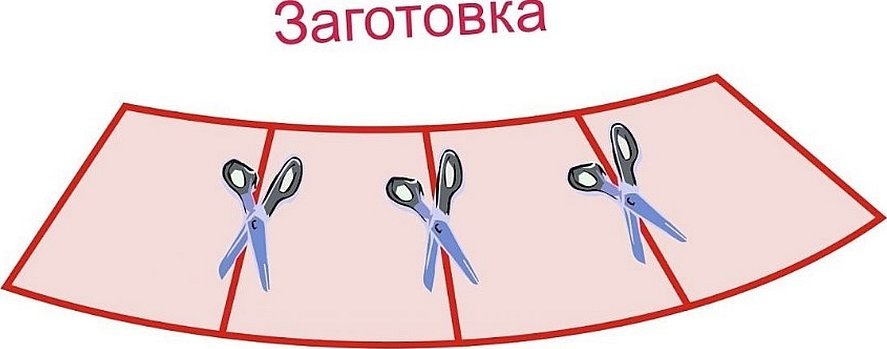
This type of ruffle has a medium level of difficulty to perform.
Construction of the pattern
A dress with a flounce on the shoulders, the pattern of which can be found in the most fashionable magazine, can be easily brought to life. To sew a chic summer sundress with a lush flounce located along the shoulder line, you can use the following options for constructing patterns:
- The simplest model with a straight silhouette without darts.
- A model with straps that provides additional fixation of the item.
- High waisted cut option.
- An item with an indefinite number of elastic bands.
- Fitted dress.
The sewing principle in each case is carried out according to an individual scheme.
Simple model
If you are not experienced in making complex patterns, then you should use the simplest options. This is the summer style of the product, which involves making all the details according to this pattern:
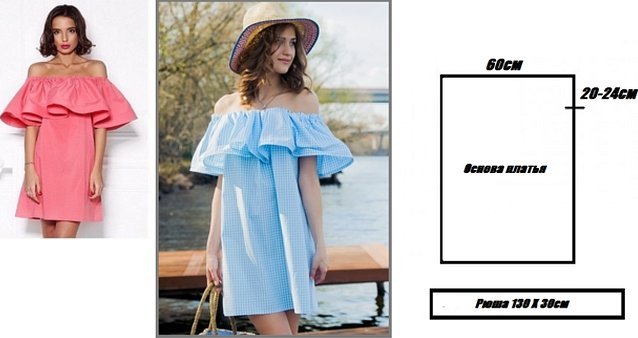
This version of the dress can be used to sew a children's summer sundress. And this version of the model will definitely suit a teenager. For women, this option can be an excellent base for a look for the beach or a picnic.
Model with straps
A sarafan with a frill on the shoulders, the pattern of which also assumes the presence of straps, is made according to the following scheme:
- The details with the folds of the front and back parts of the bodice are outlined. The same is done with the front and back panels of the skirt.
- On the fabric, mark the contours of 2 frill pieces and 2 armhole facing fragments, as well as 4 straps.
- Provide the front and back parts with marks for attaching the straps, and make 5 mm long notches on the seam allowances.
- Measure about 26 cm from the edges of each front frill, and 21 cm from the edges of the back frill. Make notches.
- Fold the bias facings of the armhole in half with the wrong side facing inward. The facing in the folded form is attached to the armhole cut. This must be done so that the open facing edges lie at a distance of 1 cm from the allowance edge.
- The facing is sewn on 5 mm from the edges. Cut off the remaining fabric.
- Sew the straps together. These pieces are attached to the bodice edge at the front and back. The marks made in advance serve as a guide.
- Next, the parts are sewn (assembled) from the inside out.
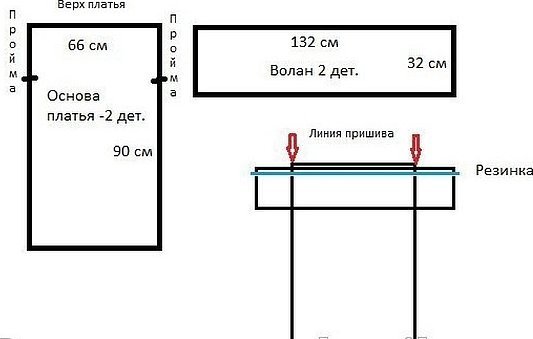
Please note! All seams are made from the wrong side. In this case, the parts are placed “face to face” between each other.
If all stages are done carefully and correctly, the product will be quite comfortable and presentable.
High waist dress
A dress with flounces and a high waist looks delicate and feminine. The dress widens towards the bottom, adding lightness to the gait. This style hides a small belly - it is an ideal option for pregnant women.
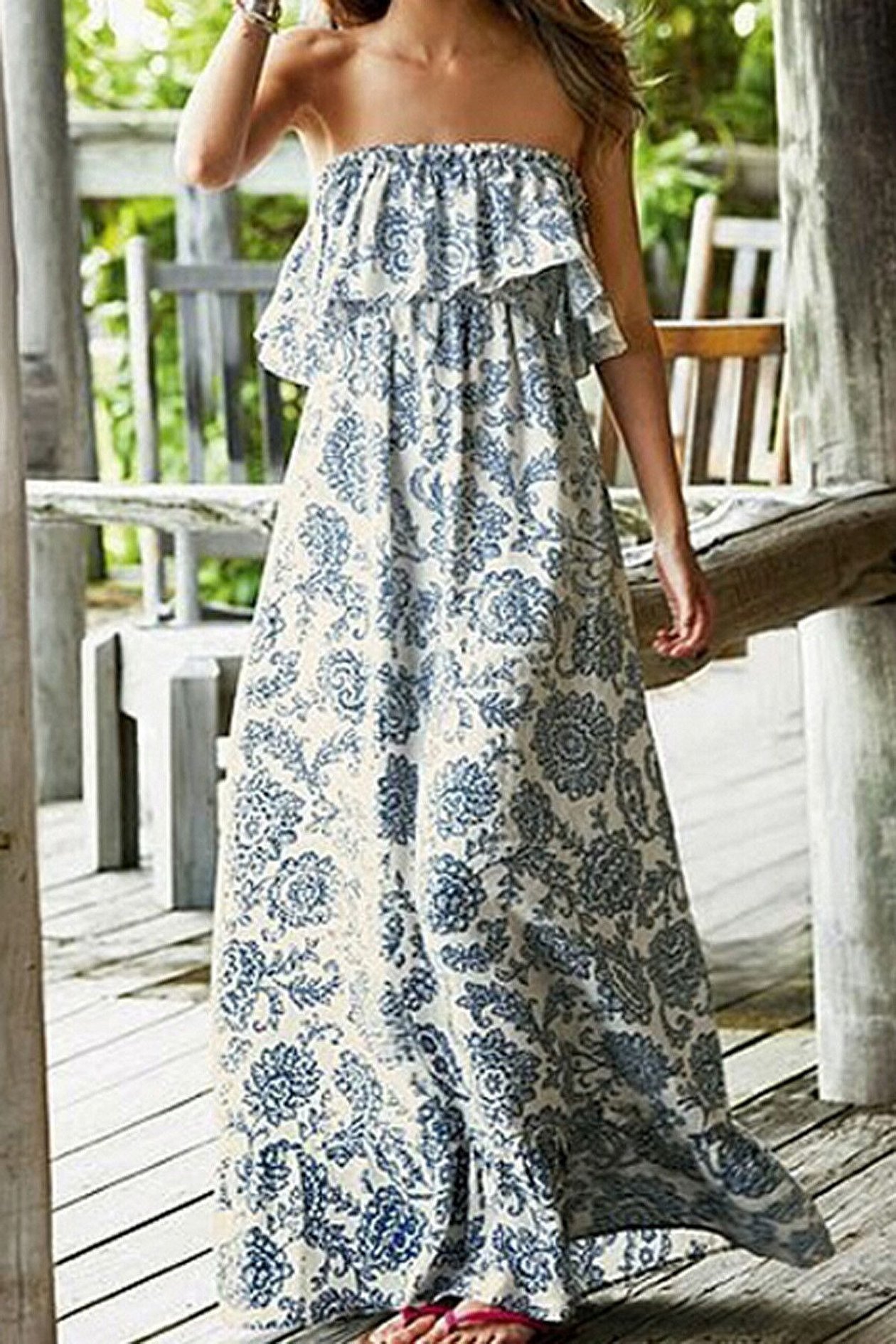
There is nothing complicated in sewing such a model. The bodice of the dress is stitched along the entire length with strips with an internal insert of material. You need to insert from 6 to 10 elastic bands, depending on the volume of the chest. A frill from 10 to 15 cm is sewn on the bottom of the dress, with light tucks that are slightly noticeable. A frill of flounces on top completely covers the bodice. You can form a neckline.
Dress with several elastic bands
This version of the product is not difficult in terms of sewing, so special skills are not needed. Algorithm on how to sew a dress with a flounce on an elastic band on the shoulders and in the waist area:
- Cut out armholes for sleeves on the rectangle according to the standard.
- Multi-layer elastic is made by sewing several parallel seams at the same distance.
- The edge of the frill is formed at the desired length.

It is worth adding a frill to the sleeves, decorate the bottom of the dress with frills, from one to three. Lace details look beautiful here.
Fitted silhouette model
Usually, a fitted dress is made of elastic knitwear. Such a thing looks especially impressive with a maxi length. Step-by-step master class on making:
- From the center of the bottom, draw a perpendicular upwards, which marks the middle of the dress. The top point of the perpendicular will become the area in which the 7th cervical vertebra is located.
- A mark is left on the center line, which determines the length of the back to the waist.
- The upper section is divided in half. The chest line is drawn according to the obtained point.
- The chest half-girth measurement is measured along the chest line.
- The waist measurements are marked on the waist line. The side cuts are smoothly carried out to the very bottom.
- Along the chest line, where the armholes are located, a few centimeters are added at the back.
- The sheet of paper is folded in four. The obtained value is measured radially from the corner.
- The part is cut out taking into account allowances.

Important! It is necessary to take into account that one side of the pattern is cut along the cross grain, the other along the grain, and the central side along the bias.
Prepare 2 flounces of fabric. One of them is wider than the other. In the same way, you can make a wrap dress. But in this case, you should choose a non-elastic fabric.
Number of cutting parts
The complexity of the product largely depends on the number of parts it consists of. According to the standard, such models have at least 3 cut parts. They are represented by the front part, the back part and the frill itself. If the model is a little more complex, the number of parts can increase significantly. In addition, straps can appear at the top. Several tiers of frills are used at the bottom.
Sewing
To create such a model, you need to prepare a sewing machine. In some cases, an awl is required (for sewing particularly dense areas of fabric). The principle of sewing such a product is not difficult, but still consists of several stages:
- Prepare a pattern and cut out the templates.
- Use an overlock to process all fabric edges.
- Sweep away the parts.
- Afterwards, perform the final stitching of the parts.
All that remains is decoration, which can consist of sewing beads or seed beads on particularly striking parts of the dress. A thin or wide belt will be a relevant accessory for many models.
Difficulties may arise at the moment of cutting and sewing the flounce itself to the base of the item. However, if you follow the basic instructions, then this problem will become irrelevant.
Dresses with open shoulders and a flounce along their line have been considered relevant for several seasons in a row, and are definitely not going to go out of fashion. If earlier they were used as summer sundresses, now there are also evening dresses made of very expensive and beautiful fabric. You can sew the product yourself. It is enough to take measurements and decide on the model. There are very simple sewing patterns for such things that even an inexperienced needlewoman can implement.




